That First Cover
We did a poll on the state of the American woman, and we needed a picture that would speak to women. It would be the first cover I would work on at TIME. I called Ralph Gibson, an extraordinary fine arts photographer, whose collections have shown in museums all over the world. Back in the 1970s, he had made a picture of the eye of a woman. We wanted him to make a new picture inspired by that image. But when I went down to his studio in New York City, he didn’t have a model that he wanted to work with. It just so happened that one of my friends in New York was getting married that weekend, and one of her friends was in town from L.A. She’s Greek, and she has very strong features, and I thought she’d be a great model. She came down to the studio, and Ralph loved her.
Homeward Bound
Yuri Kozyrev, who’s a terrific photojournalist, spent years in Iraq for TIME during the height of the war. We sent him back as the troops were starting to pull out, and he spent three weeks there on an embedded mission. He was able to get onto this plane and make this picture in one minute. He just snapped it and got off. You just want to keep staring at all the faces and the details of all these guys.
After the Earthquake
The earthquake in Haiti took place on a Tuesday. No one knew how devastating it would be, but at a “news weekly,” you have to be prepared for those kinds of events. We sent two photographers, Timothy Fadek and Shaul Schwarz, to Haiti for two weeks, and because they arrived on Wednesday, they were still able to get into the country to document the aftermath.
It was an intense story to cover. They were working around the clock. They’d shoot all day, then file the images to us at night, and then they’d get up the next day, and do it all over again. You can imagine how emotional it was to document that story for two weeks straight with little sleep.
There’s one image of a Haitian who was shot during the looting. Considering the subject, we had a lot of conversations about what we could run and what we couldn’t run. It’s important for us to make sure we’re being accurate and representing the story. In the end, we agreed that the looting was a really big part of that story, and this was a scene that really captured that danger.
After Fadek and Schwarz returned, we sent photographer James Nachtwey for another 10 days. The picture that we ran in the last spread of the Nachtwey story, I think, is one of the most stunning pictures of the year. There was a pile of bodies outside the morgue, and people were just walking by. The bodies were just being dumped on the ground.
Yuri Kozyrev, who’s a terrific photojournalist, spent years in Iraq for TIME during the height of the war. We sent him back as the troops were starting to pull out, and he spent three weeks there on an embedded mission. He was able to get onto this plane and make this picture in one minute. He just snapped it and got off. You just want to keep staring at all the faces and the details of all these guys.
Early pictures showed dump trucks that were used to haul bodies out to these fields to be placed in mass graves, and then three weeks later, when Nachtwey was shooting, these same dump trucks were hauling food–as well as groups of men–to a camp for the displaced. For us, the dump truck was a really awful, iconic part of this story.
The Faces of New Orleans
Photographer Mario Tama was in New Orleans for Hurricane Katrina and the months that followed. He made some award-winning pictures during that period. On the anniversary of Katrina, we used some of his best pictures from that time.
This portrait looks like it should be on a museum wall. There’s something very powerful and evocative about it. That’s an example of an excellent picture that wasn’t commissioned for us but that fit in a larger body of work that we were trying to pull together–in this case, anniversary coverage of a major catastrophe.
Party Time
Deadlines at TIME can be intense. The Tea Party cover of Sept. 27, 2010, was an example of a cover we pulled off in just a couple of hours. A lot of Tea Party candidates had turned important elections on Sept. 21. We had a cover that was already finished and ready to be shipped, but when I came in on the 22nd, the editor said the cover would change. So the art director had the idea to produce an image of an elephant drowning in a tea cup.
At 1:30 on the day the magazine was set to ship to the printer, I went down to Macy’s, picked up a tea cup and went to Horacio Salinas’ studio. He photographed it, and then the art director “Photoshopped” that elephant in. We were shooting this cover at 4 p.m., and it shipped at 6 p.m. That’s how fast things wrap up sometimes. You can be as organized as you want, but if a news story breaks, you have to be ready.
The Three-Minute Photo Shoot
Photographers have very little time with subjects like Steve Jobs or politicians or celebrities or athletes, and I don’t think readers understand that it is actually a coup to get a portrait session with someone so famous. Basically you have a photographer–in this case Marco Grob–spend a couple of hours setting up lights, so that when the subject walks onto the set, the photographer can make that picture in three minutes. And that is about the time that we had with Jobs–three to six minutes.
Bebe’s Cover
This was a story about animal cognition, and we knew there were certain animals that the reporter was going to be writing about. We knew, for instance, that there was a bonobo, which is a kind of ape, that he was going to be sitting with and talking to, and we photographed that actual ape in the Midwest. We also knew an elephant was going to be in the piece. When you’re doing these stories, there are agencies that have animals you can “hire” for advertising, so we called a lot of those places. But when it came to the dog, we had Finlay MacKay photograph my friend’s pug, Bebe. The dog is just hilarious–a character, really. It was an immediate cover.
The Women of Afghanistan
Obviously, this is a very controversial cover, and it’s a really tough picture. We were doing a story on the progress of women in Afghanistan, and Jodi Bieber, a South African photographer, shot a number of portraits for the story, including a woman who’s in the Parliament in Afghanistan, a woman who is an Oprah-like talk show host there, and a woman who is an Olympic athlete. But the story was about where progress is being made, and where it isn’t. One of the women in the piece is an 18-year-old who ran away from her husband. She was put in jail in Kandahar, and a month later, she was brought back to her family. The Taliban then ordered her nose to be cut off by her husband and his brother. She eventually escaped again and ended up in a shelter where the American military gave her medical attention. She’s now in California receiving a lot of reconstructive surgery. This picture just had so much power and really showed what women in Afghanistan have gone through. The story is horrifying, but there’s a beauty to the picture– there’s something compelling about her eyes that makes you stay with it. At first you want to turn away, but it forces you to look at it, and it forces you to have a conversation about it.
Hair Gone Wild
TIME had been covering Detroit all year. We bought a house there for photographers, editors, and writers to use, and we did many different stories on the city. We invested a lot of resources into what we called “Project Detroit.” A writer told us about these hair wars, in which people would come up with incredible hair designs. It was a big competition. These images could have been done journalistically, they could have been staged, or they could have documented the process of these women having their hair done. They could have pictured the minions and the models and the stylists who are putting it all together. Instead, we chose to do really stunning, artful portraits. We thought photographer Peter Hapak would be perfect for this project because he brings an artfulness to his lighting, and he photographs women–and captures skin tones–in beautiful ways.
Pictures of the President
Photographer Callie Shell has documented Obama for years. She started when he was in the Senate, so she had developed a relation- ship with him over time. She covered the Obama campaign and the election for TIME, so when Joe Klein wrote a cover story on Obama for our Feb. 1, 2010 issue, we sent her to the White House to spend a day with the President. At one point, she was in the car with him. We used that as the opening picture for the story, because it’s an unusual picture of Obama–you just don’t get that close to him. I think that’s the power of her vision and her reporting and her relationship with Obama, and it’s also the power of TIME. You feel like you’re “inside” with the President. You’re in the car with him. You’re in the Oval Office. You’re in a meeting with him and Larry Summers. Journalistically, you want that intimacy.
Miss Gaga
One of our annual issues is “TIME 100,” in which we pick the 100 most influential people of the year. We photographed Lady Gaga in London. As a fashion icon, she can be pretty controlling in how she wants her image portrayed. She came to the set with this outfit that was basically fireworks coming out of her bra. It was just so over-the- top, but the picture is elegant. I should mention that this is not “Photoshopped” at all, and at a certain point, the flint in the bra ran out. So Lady Gaga had an assistant run out for more. She’s an extraordinary woman, and I do think that this image by Marco Grob is one of the great portraits of the ages.

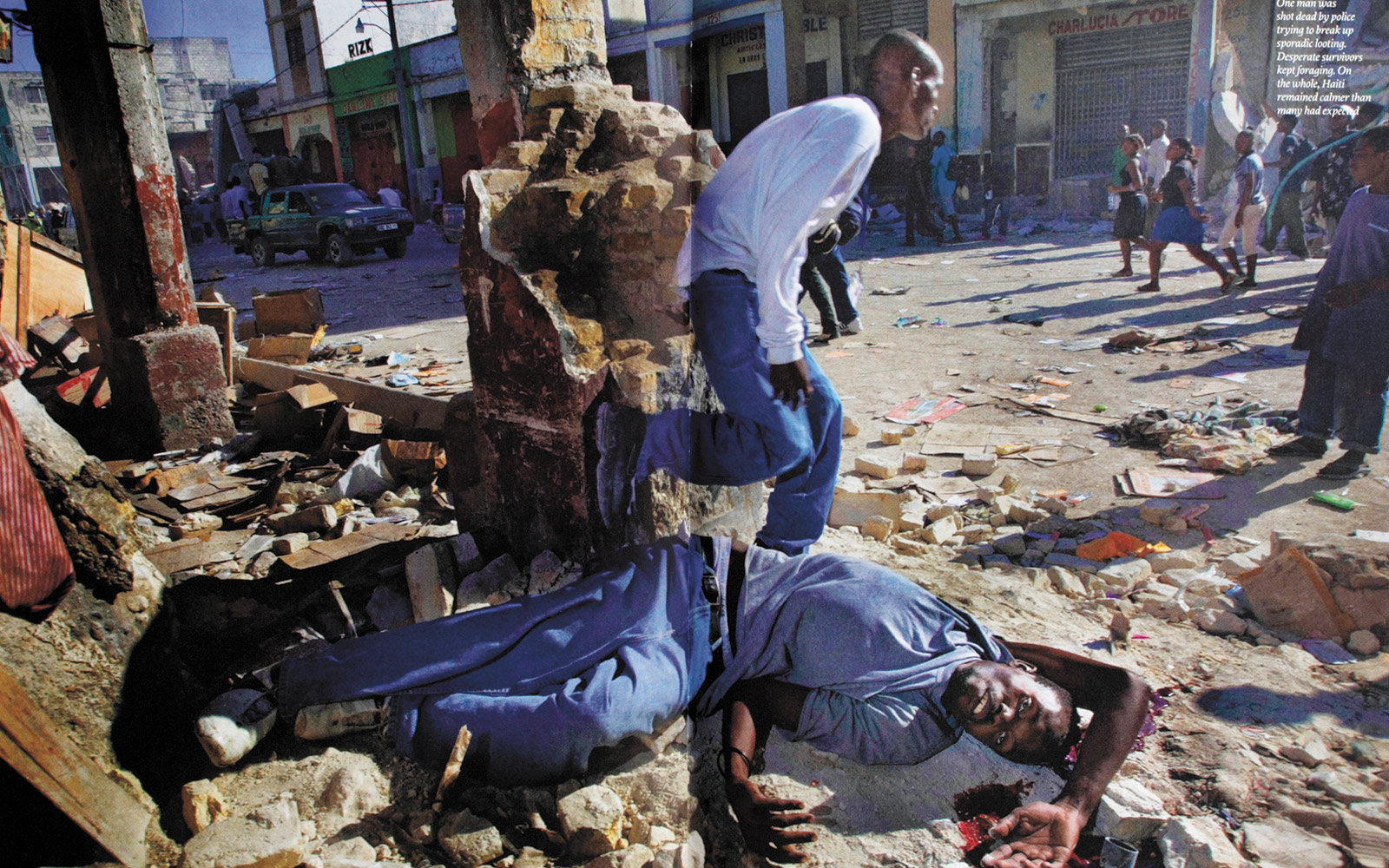
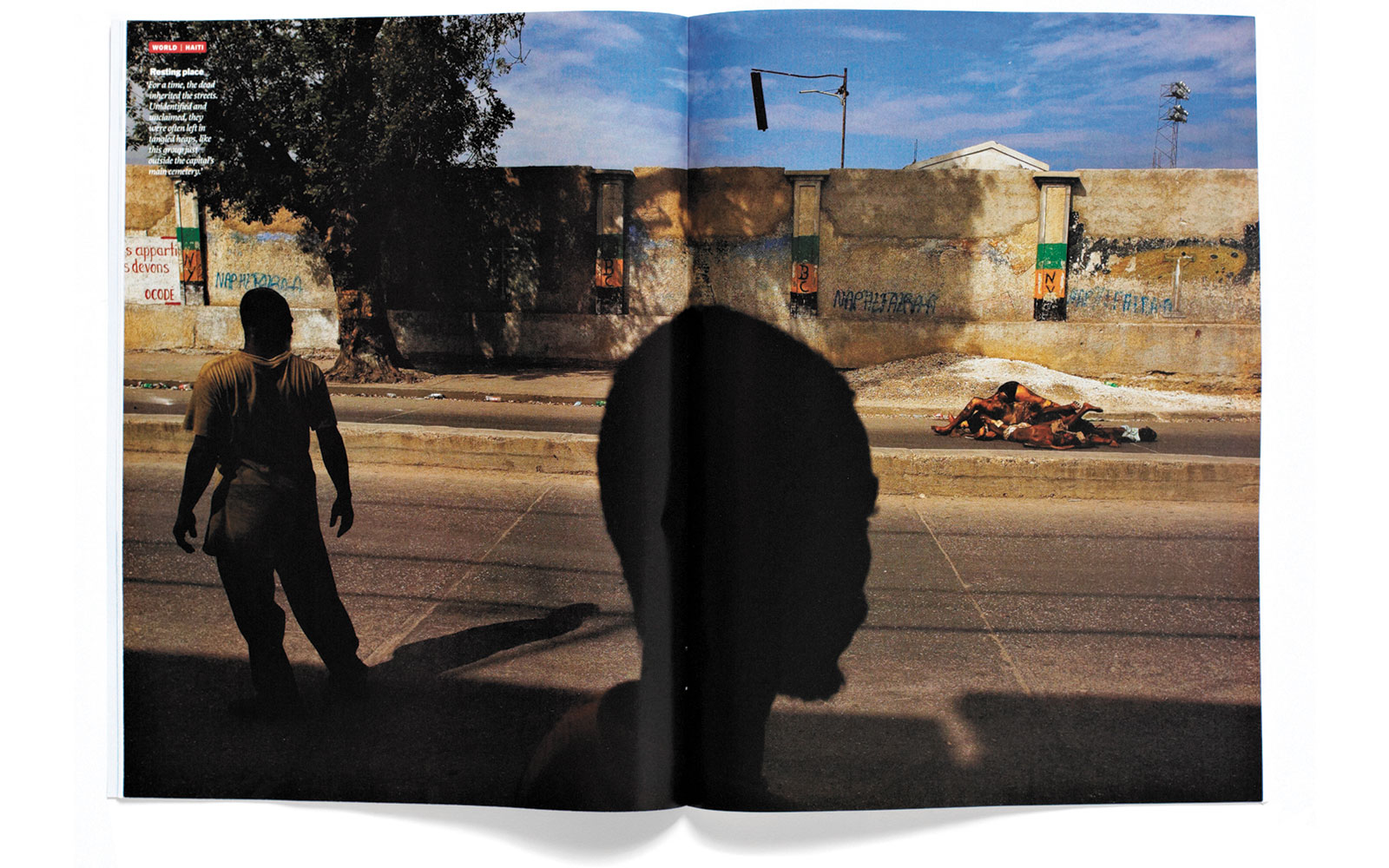
After the Earthquake
The earthquake in Haiti took place on a Tuesday. No one knew how devastating it would be, but at a “news weekly,” you have to be prepared for those kinds of events. We sent two photographers, Timothy Fadek and Shaul Schwarz, to Haiti for two weeks, and because they arrived on Wednesday, they were still able to get into the country to document the aftermath.
It was an intense story to cover. They were working around the clock. They’d shoot all day, then file the images to us at night, and then they’d get up the next day, and do it all over again. You can imagine how emotional it was to document that story for two weeks straight with little sleep.
There’s one image of a Haitian who was shot during the looting. Considering the subject, we had a lot of conversations about what we could run and what we couldn’t run. It’s important for us to make sure we’re being accurate and representing the story. In the end, we agreed that the looting was a really big part of that story, and this was a scene that really captured that danger.
After Fadek and Schwarz returned, we sent photographer James Nachtwey for another 10 days. The picture that we ran in the last spread of the Nachtwey story, I think, is one of the most stunning pictures of the year. There was a pile of bodies outside the morgue, and people were just walking by. The bodies were just being dumped on the ground.
Yuri Kozyrev, who’s a terrific photojournalist, spent years in Iraq for TIME during the height of the war. We sent him back as the troops were starting to pull out, and he spent three weeks there on an embedded mission. He was able to get onto this plane and make this picture in one minute. He just snapped it and got off. You just want to keep staring at all the faces and the details of all these guys.
Early pictures showed dump trucks that were used to haul bodies out to these fields to be placed in mass graves, and then three weeks later, when Nachtwey was shooting, these same dump trucks were hauling food–as well as groups of men–to a camp for the displaced. For us, the dump truck was a really awful, iconic part of this story.
The Faces of New Orleans
Photographer Mario Tama was in New Orleans for Hurricane Katrina and the months that followed. He made some award-winning pictures during that period. On the anniversary of Katrina, we used some of his best pictures from that time.
This portrait looks like it should be on a museum wall. There’s something very powerful and evocative about it. That’s an example of an excellent picture that wasn’t commissioned for us but that fit in a larger body of work that we were trying to pull together–in this case, anniversary coverage of a major catastrophe.
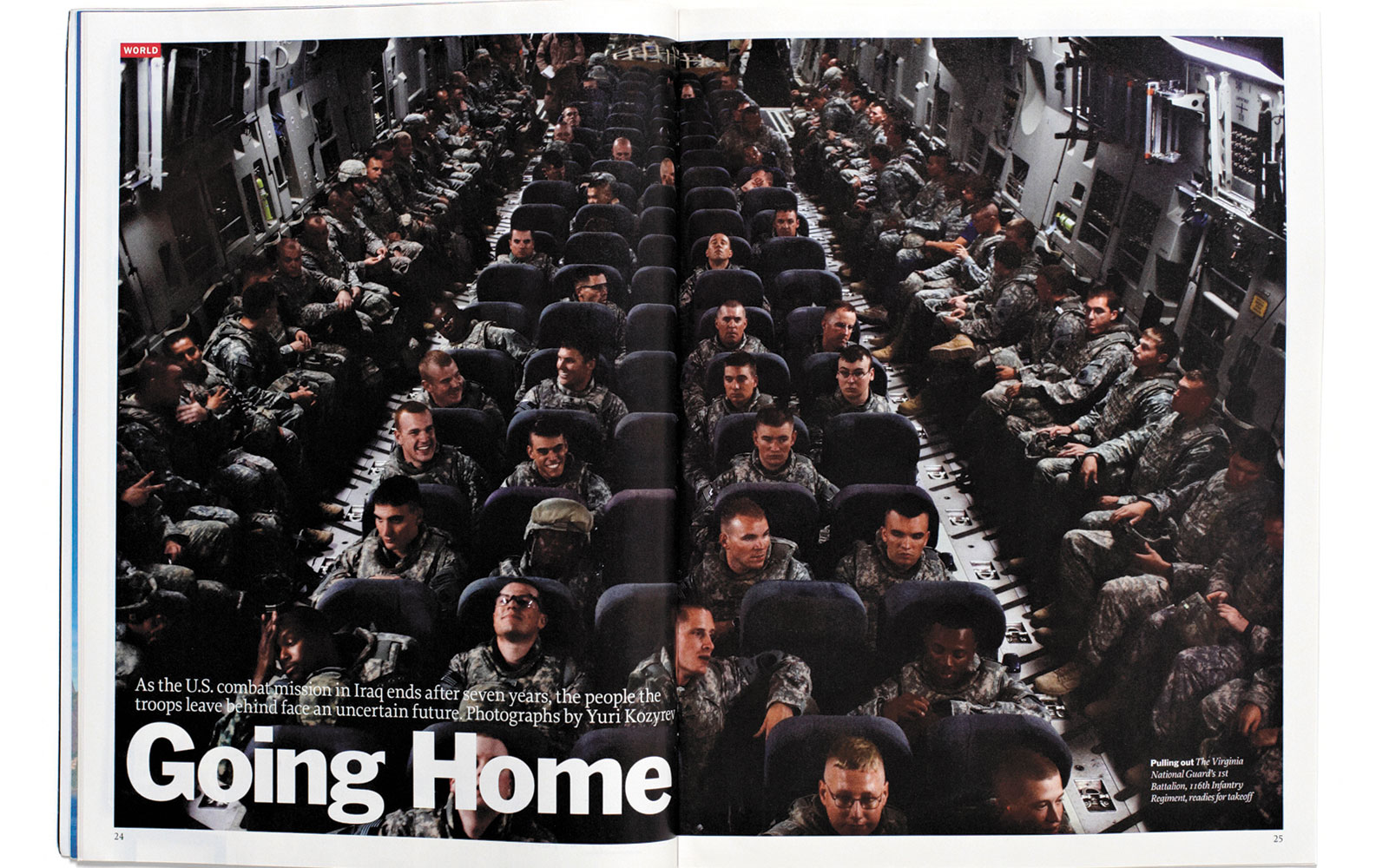
Homeward Bound
Yuri Kozyrev, who’s a terrific photojournalist, spent years in Iraq for TIME during the height of the war. We sent him back as the troops were starting to pull out, and he spent three weeks there on an embedded mission. He was able to get onto this plane and make this picture in one minute. He just snapped it and got off. You just want to keep staring at all the faces and the details of all these guys.

The Faces of New Orleans
Photographer Mario Tama was in New Orleans for Hurricane Katrina and the months that followed. He made some award-winning pictures during that period. On the anniversary of Katrina, we used some of his best pictures from that time.
This portrait looks like it should be on a museum wall. There’s something very powerful and evocative about it. That’s an example of an excellent picture that wasn’t commissioned for us but that fit in a larger body of work that we were trying to pull together—in this case, anniversary coverage of a major catastrophe.

Party Time
Deadlines at TIME can be intense. The Tea Party cover of Sept. 27, 2010, was an example of a cover we pulled off in just a couple of hours. A lot of Tea Party candidates had turned important elections on Sept. 21. We had a cover that was already finished and ready to be shipped, but when I came in on the 22nd, the editor said the cover would change. So the art director had the idea to produce an image of an elephant drowning in a tea cup.
At 1:30 on the day the magazine was set to ship to the printer, I went down to Macy’s, picked up a tea cup and went to Horacio Salinas’ studio. He photographed it, and then the art director “Photoshopped” that elephant in. We were shooting this cover at 4 p.m., and it shipped at 6 p.m. That’s how fast things wrap up sometimes. You can be as organized as you want, but if a news story breaks, you have to be ready.
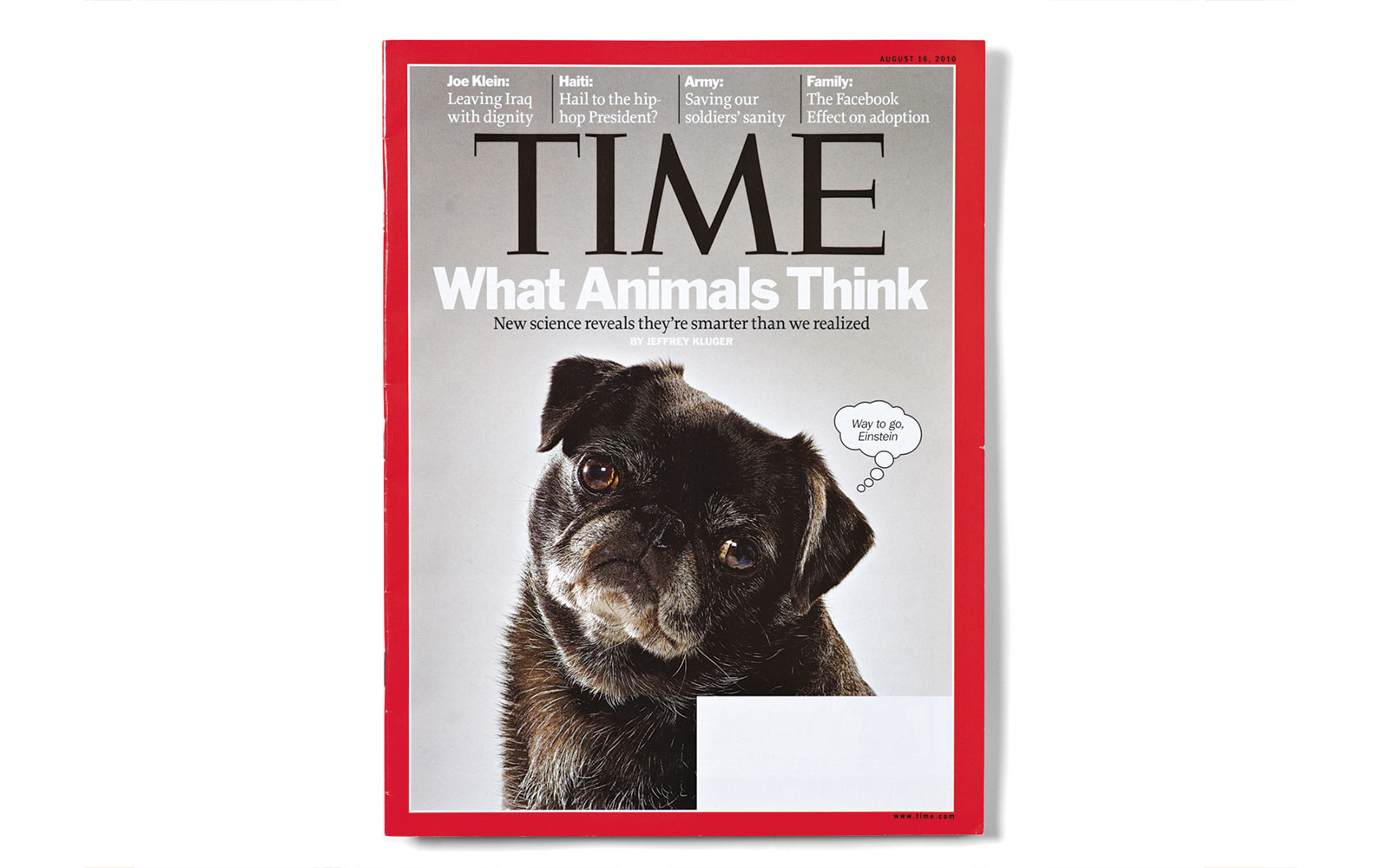
Bebe’s Cover
This was a story about animal cognition, and we knew there were certain animals that the reporter was going to be writing about. We knew, for instance, that there was a bonobo, which is a kind of ape, that he was going to be sitting with and talking to, and we photographed that actual ape in the Midwest. We also knew an elephant was going to be in the piece. When you’re doing these stories, there are agencies that have animals you can “hire” for advertising, so we called a lot of those places. But when it came to the dog, we had Finlay MacKay photograph my friend’s pug, Bebe. The dog is just hilarious–a character, really. It was an immediate cover.

The Three-Minute Photo Shoot
Photographers have very little time with subjects like Steve Jobs or politicians or celebrities or athletes, and I don’t think readers understand that it is actually a coup to get a portrait session with someone so famous. Basically you have a photographer–in this case Marco Grob–spend a couple of hours setting up lights, so that when the subject walks onto the set, the photographer can make that picture in three minutes. And that is about the time that we had with Jobs–three to six minutes.
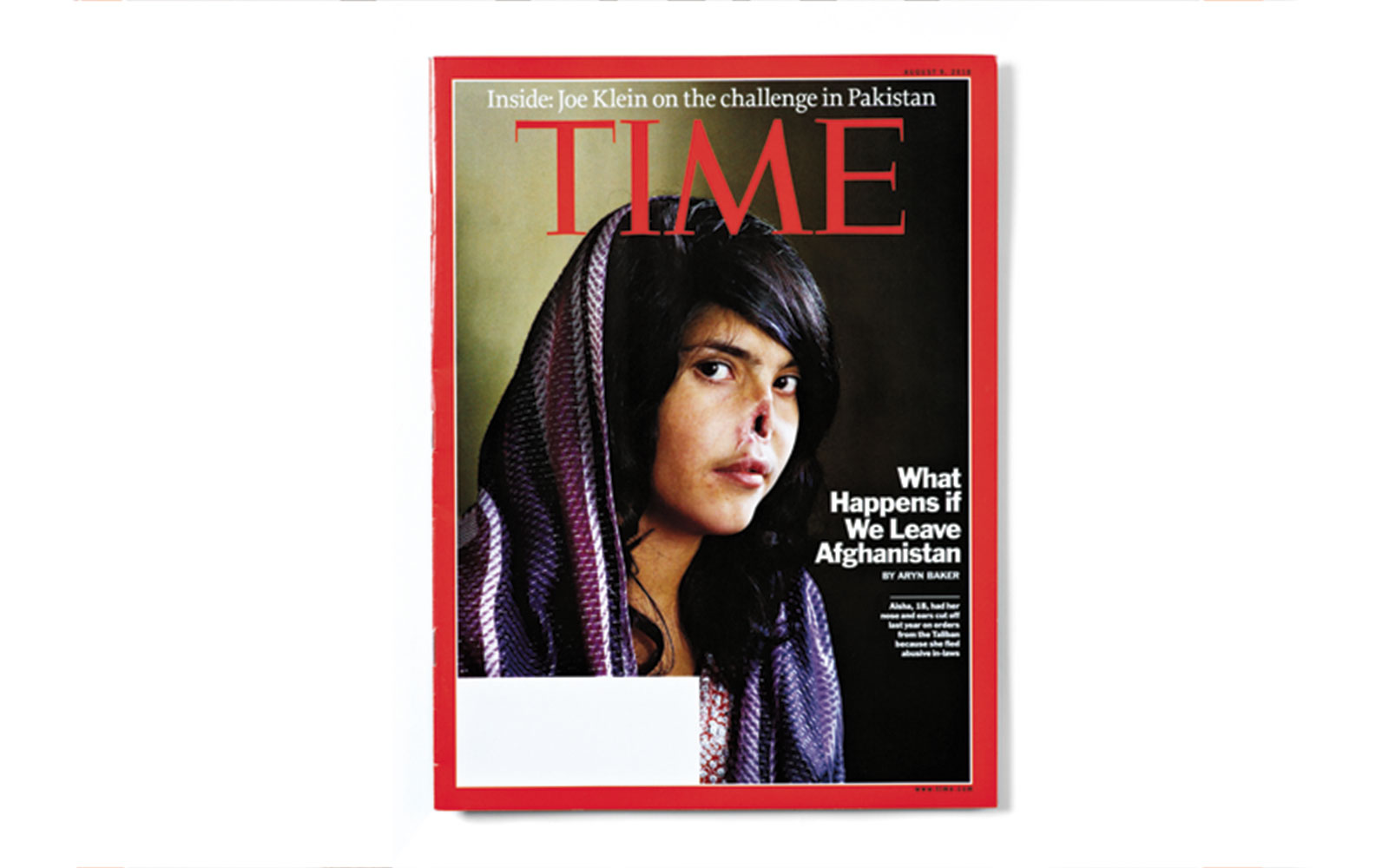
The Women of Afghanistan
Obviously, this is a very controversial cover, and it’s a really tough picture. We were doing a story on the progress of women in Afghanistan, and Jodi Bieber, a South African photographer, shot a number of portraits for the story, including a woman who’s in the Parliament in Afghanistan, a woman who is an Oprah-like talk show host there, and a woman who is an Olympic athlete. But the story was about where progress is being made, and where it isn’t. One of the women in the piece is an 18-year-old who ran away from her husband. She was put in jail in Kandahar, and a month later, she was brought back to her family. The Taliban then ordered her nose to be cut off by her husband and his brother. She eventually escaped again and ended up in a shelter where the American military gave her medical attention. She’s now in California receiving a lot of reconstructive surgery. This picture just had so much power and really showed what women in Afghanistan have gone through. The story is horrifying, but there’s a beauty to the picture– there’s something compelling about her eyes that makes you stay with it. At first you want to turn away, but it forces you to look at it, and it forces you to have a conversation about it.

Hair Gone Wild
TIME had been covering Detroit all year. We bought a house there for photographers, editors, and writers to use, and we did many different stories on the city. We invested a lot of resources into what we called “Project Detroit.” A writer told us about these hair wars, in which people would come up with incredible hair designs. It was a big competition. These images could have been done journalistically, they could have been staged, or they could have documented the process of these women having their hair done. They could have pictured the minions and the models and the stylists who are putting it all together. Instead, we chose to do really stunning, artful portraits. We thought photographer Peter Hapak would be perfect for this project because he brings an artfulness to his lighting, and he photographs women–and captures skin tones–in beautiful ways.
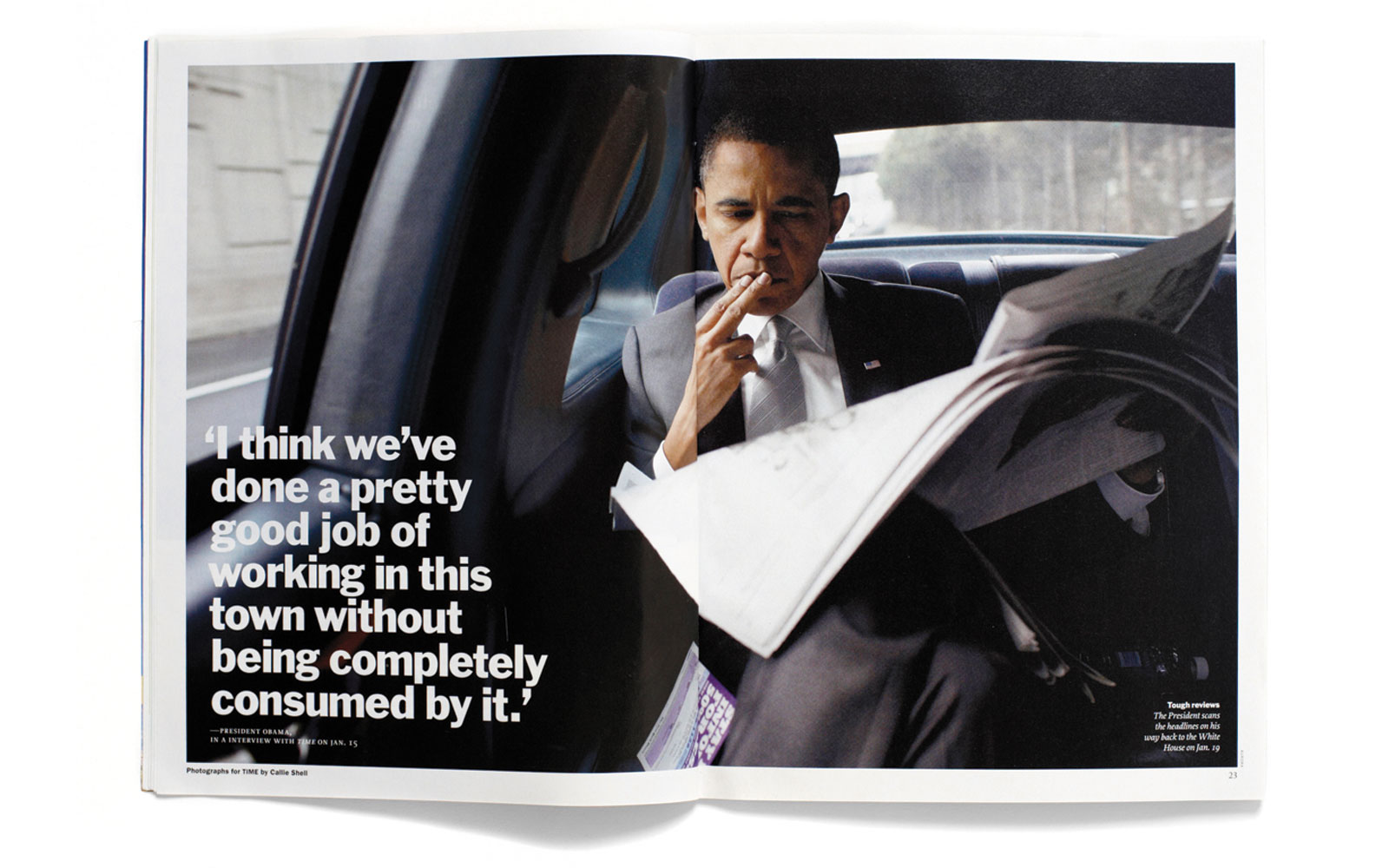
Pictures of the President
Photographer Callie Shell has documented Obama for years. She started when he was in the Senate, so she had developed a relation- ship with him over time. She covered the Obama campaign and the election for TIME, so when Joe Klein wrote a cover story on Obama for our Feb. 1, 2010 issue, we sent her to the White House to spend a day with the President. At one point, she was in the car with him. We used that as the opening picture for the story, because it’s an unusual picture of Obama–you just don’t get that close to him. I think that’s the power of her vision and her reporting and her relationship with Obama, and it’s also the power of TIME. You feel like you’re “inside” with the President. You’re in the car with him. You’re in the Oval Office. You’re in a meeting with him and Larry Summers. Journalistically, you want that intimacy.
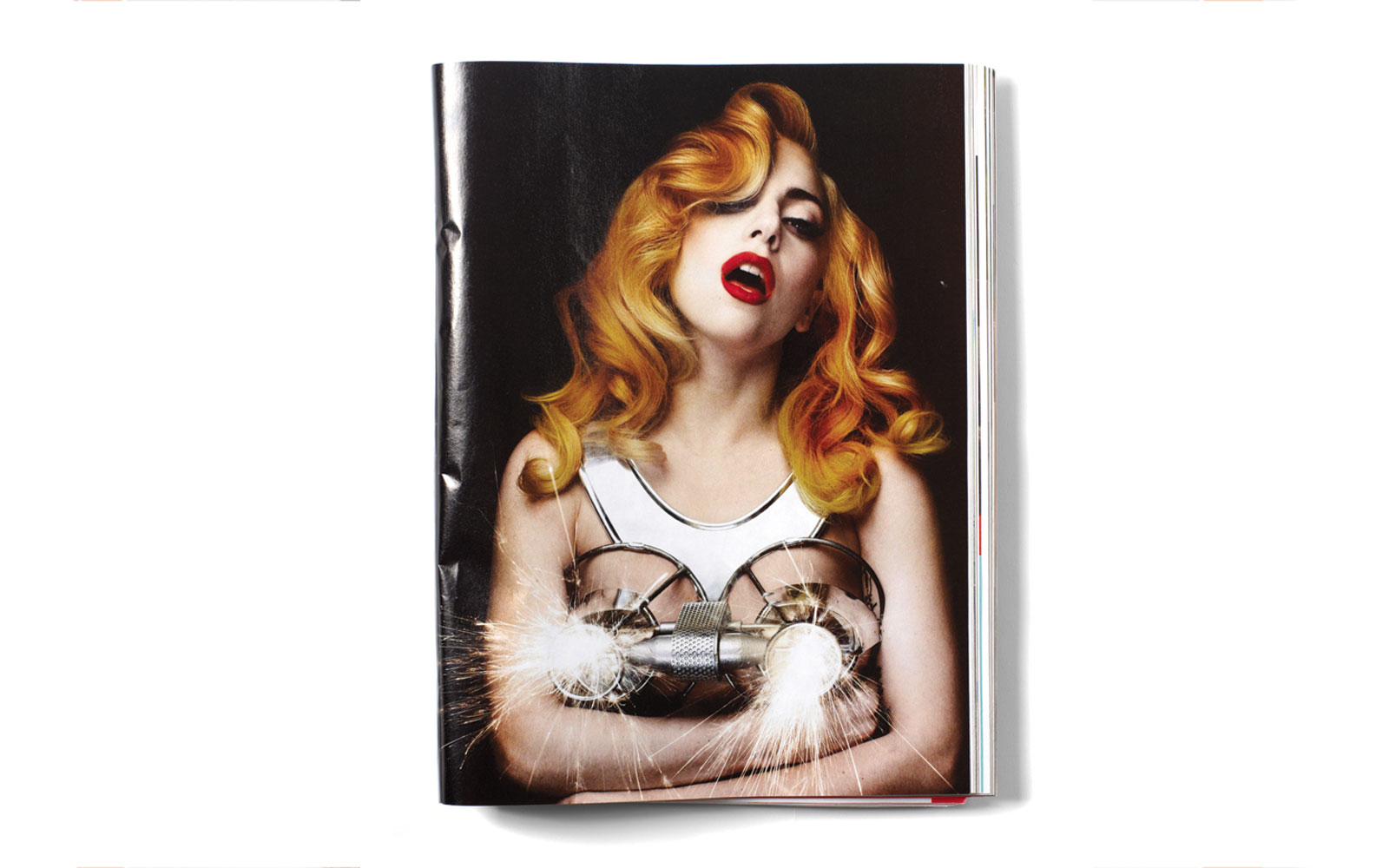
Miss Gaga
One of our annual issues is "TIME 100," in which we pick the 100 most influential people of the year. We photographed Lady Gaga in London. As a fashion icon, she can be pretty controlling in how she wants her image portrayed. She came to the set with this outfit that was basically fireworks coming out of her bra. It was just so over-the- top, but the picture is elegant. I should mention that this is not "Photoshopped" at all, and at a certain point, the flint in the bra ran out. So Lady Gaga had an assistant run out for more. She's an extraordinary woman, and I do think that this image by Marco Grob is one of the great portraits of the ages.

